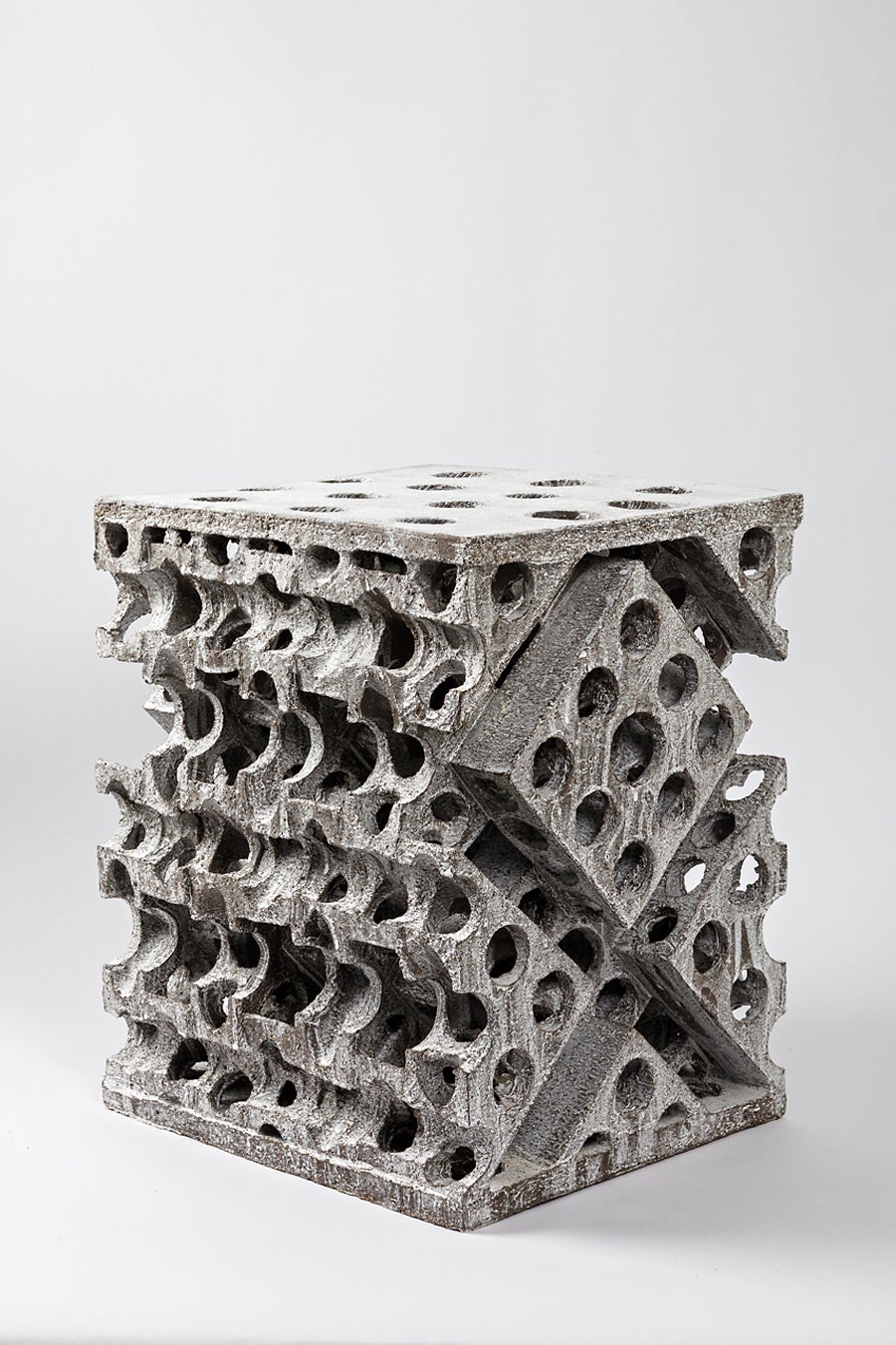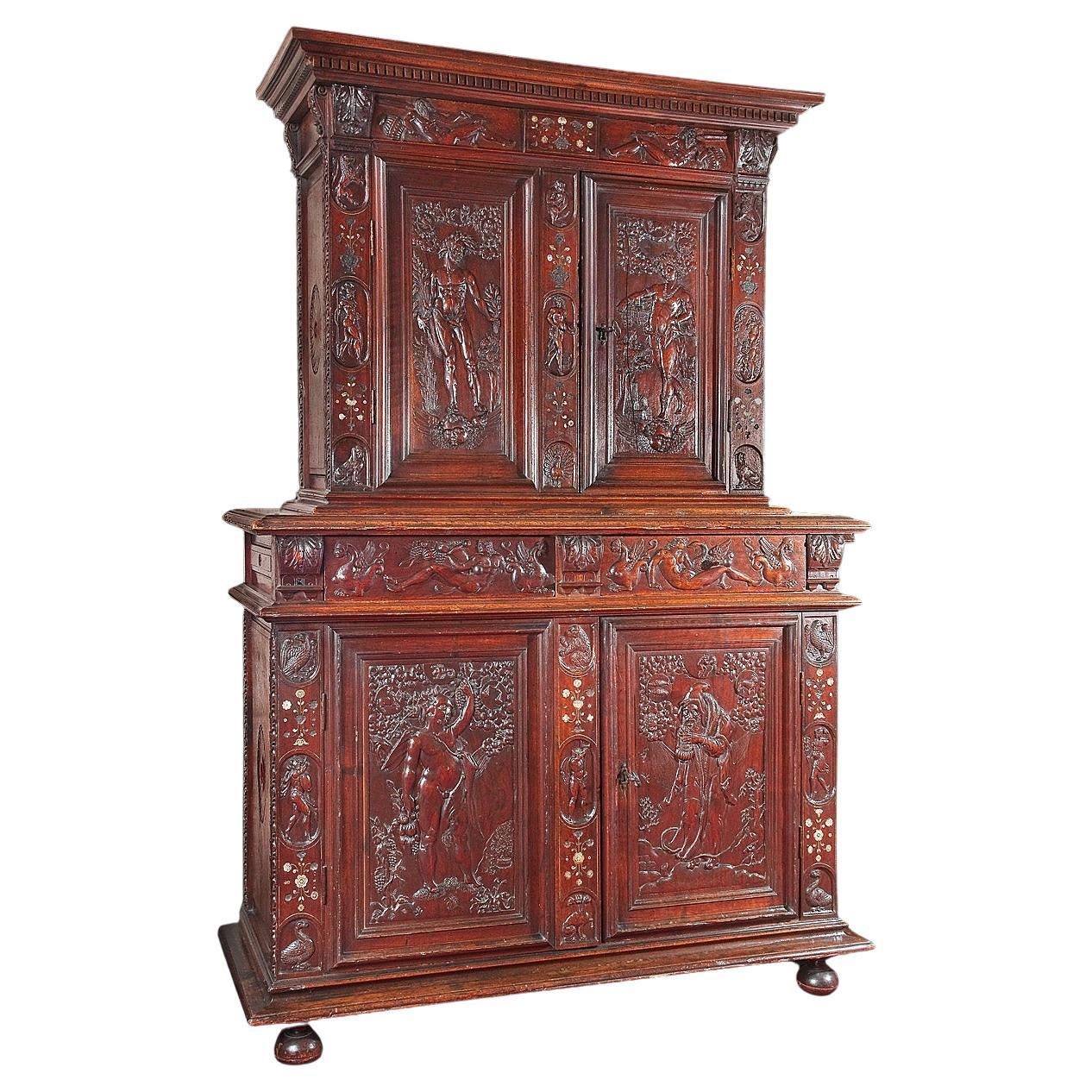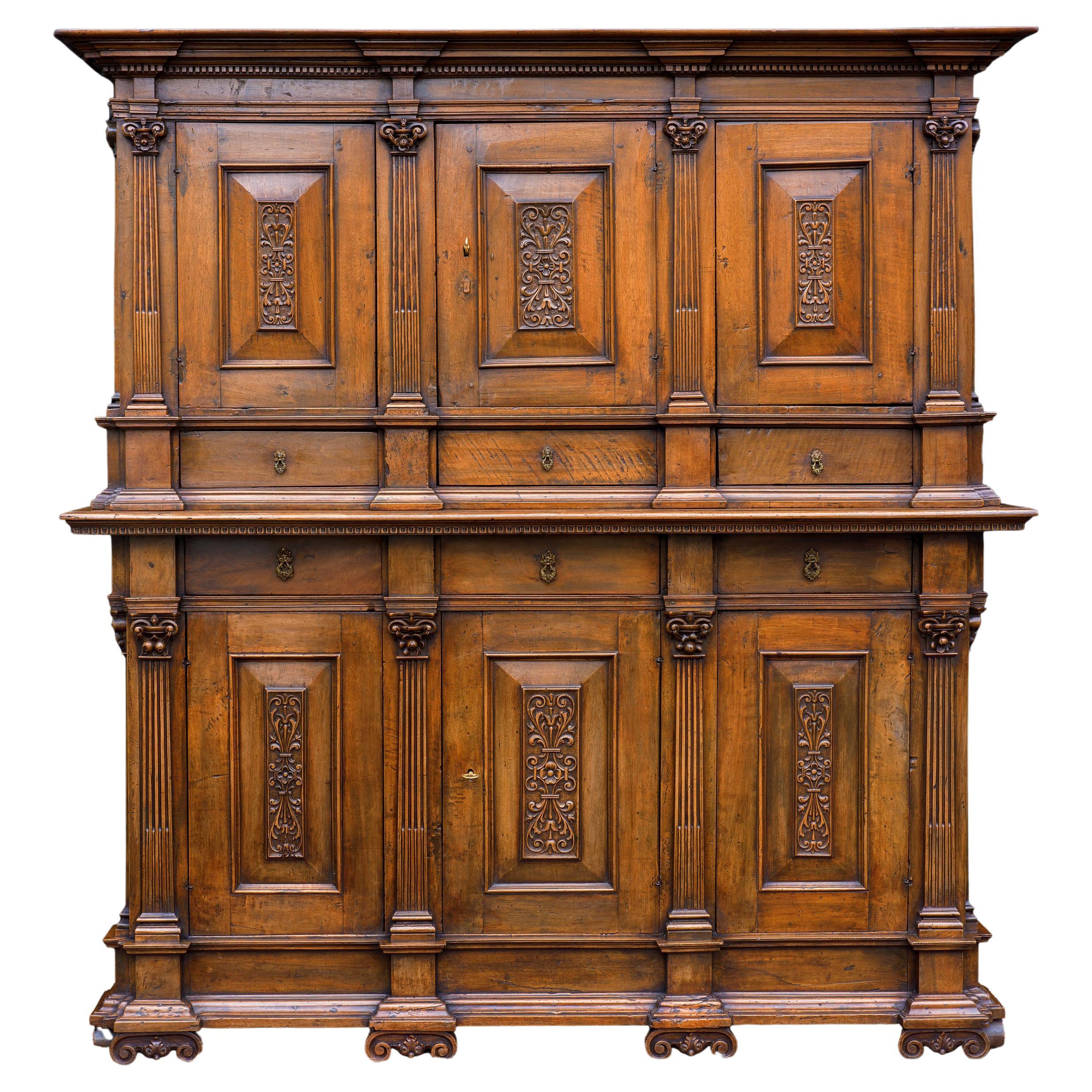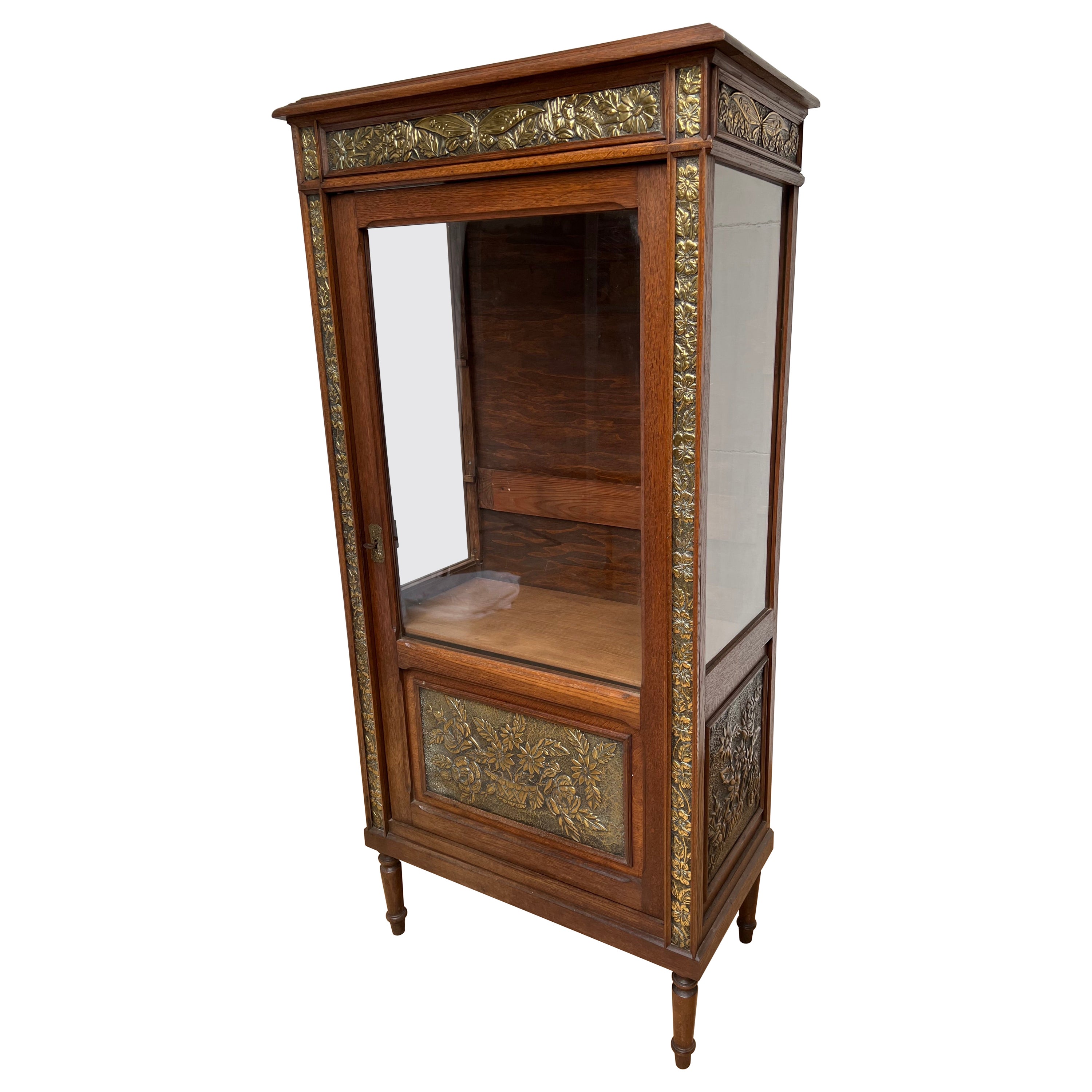Items Similar to Rare Renaissance Florentine Cabinet with Certosina Decoration
Want more images or videos?
Request additional images or videos from the seller
1 of 8
Rare Renaissance Florentine Cabinet with Certosina Decoration
About the Item
RARE RENAISSANCE FLORENTINE WALNUT CABINET WITH CERTOSINA DECORATION
ORIGIN: FLORENCE, ITALY
PERIOD: END OF 15th CENTURY – BEGINNING OF 16th CENTURY
Height: 129 cm
Length: 107 cm
Depth: 50 cm
Walnut and veneer (cedar, ebony, maple, poplar)
This small cabinet with two doors in the front and a drawer is a synthesis of sculpture and marquetry, different techniques that were very popular during the Italian Renaissance.
Perfectly structured, it imitates the facades of ancient temples.
The two leaves are framed by two pilasters that rise from a slightly projecting moulded base. The base decorated with a rose window frames a long drawer. The pilasters are carved with plant motifs. Two capitals with acanthus baskets crown them and support a powerful entablature with a particularly overhanging cornice. A frieze of stars in marquetry is set between two beautiful flowers.
Each leaf is divided into two almost square panels surrounded by marquetry filleting depicting geometric motifs. The upper panels are decorated with fine scrolls forming interlaces while the two lower panels are carved with double corolla flowers.
A frieze of foliage symmetrically frames a coat of arms.
The small and elegant proportions of this cabinet, the vigour of its sculpture, the refinement of its marquetry along with its volumes make it a piece of furniture of great quality
HISTORIC
At the end of the 15th century, Florence was home to numerous marquetry and woodcarving workshops. The golden age of intarsia, the marquetry of wood, took place between 1470 and 1520.
During the 15th century, intarsia was limited to light, sober and sparingly distributed friezes. The end of the quattrocento witnesses a greater use of marquetry turning pieces of wood into real palatial pieces.
This furniture, isfoggiato, as opposed to the very regulated fogia furniture ( only one type of wood, cornice forbidden, board's uniform thickness ) was a real sumptuary expense requiring for their realization an authorization of the Arte dei Legnaioli and the payment of a tax.
Often compared stylistically to Middle Eastern craftsmanship, of which certain groups could be found in Venice or Florence, the origin of intarsia is to be found beyond that in the cosmatesque (stone mosaics). Both for its techniques and style, the work of the Cosmati marble makers and their successors, applied to church pavements and pieces such as wall facings or ambos, leads us to see intarsia as a true evolution and derivation of this craft. Moreover, it was common for some of the best wood markers, such as Domenico del Coro or Pietro del Minella, to be employed in the creation of church pavements.
Intarsia itself is divided into several varieties which differ in their processes as well as in their appearance.
On this cabinet predominates certosina ; a marquetry composed of tiny pieces of wood, most often in geometrical forms. The word certosina originates from the work produced by the carthusians. Disciples of Saint Bruno applied themselves for centuries to the patient making of wood or mother-of-pearl inlays, bone or ivory marqueteries, whose purpose was to enrich ecclesiastical furniture.
Certosina spread beyond the monastic order to reach Florentine workshops amongst others. When intarsia pittorica appeared, certosina did not fade away and kept being used on furniture as bands, friezes or cornices.
- Dimensions:Height: 50.79 in (129 cm)Width: 42.13 in (107 cm)Depth: 19.69 in (50 cm)
- Materials and Techniques:
- Period:
- Date of Manufacture:16th Century
- Condition:Repaired. Wear consistent with age and use.
- Seller Location:Saint-Ouen, FR
- Reference Number:1stDibs: LU3115336040822

About the Seller
5.0
Vetted Seller
These experienced sellers undergo a comprehensive evaluation by our team of in-house experts.
Established in 2016
1stDibs seller since 2017
153 sales on 1stDibs
Typical response time: 7 hours
- ShippingRetrieving quote...Ships From: Paris, France
- Return PolicyThis item cannot be returned.
More From This SellerView All
- Rare Renaissance Cabinet with Feather quill and Fenestration DecorationLocated in Saint-Ouen, FRRARE RENAISSANCE CABINET WITH FEATHER QUILL AND FENESTRATION DECORATION ORIGIN: FRANCE PERIOD: EARLY 16th CENTURY DIMENSIONS : Height : 178 cm Length : 145 cm Depth : 58 cm Walnu...Category
Antique 16th Century Cabinets
MaterialsWalnut
- Rare Renaissance Cabinet Richly CarvedLocated in Saint-Ouen, FRThis rare Renaissance cabinet is richly decorated on the doors and drawers with carvings depicting the four seasons, and on the uprights and the entablature, alternating flower bouquets inlaid with mother of pearl. This is a beautifully conceived piece of furniture, representing a crowned portico with its entablature and cornice. The upper body Articulated separately in a ternary rhythm, as with the lower body, the upper part opens with two carved doors. The doors are framed by both the lateral uprights and the casing. There are cartouches carved into the casing in which mythological figures are depicted with flower bouquets. On the doors: On the right: Spring, a female figure crowned with a wreath of leaves, holding a basket full of flowers. She is wearing necklaces and bracelets on each arm, with drapery discretely wrapped around her body and is standing on a winged putti’s head. On each side are depicted a tree and a village with a steepled church. Above her head floats the three signs of the zodiac corresponding to the season: Aries, Taurus and Gemini. On the left: Summer, a bearded man crowned with ears of corn and bearing armfuls of corn. He is standing on a similar winged putti, flanked by a tree and an ear of corn. The following three signs of the zodiac appear: Cancer, Leo and Virgo. On the uprights and the central casing a number of smaller figures seem to represent virtues and vices that newly wedded couples should aspire to and avoid. On each side, at the bottom of the uprights, there is a dog representing fidelity. Above, a lion embodies power, wisdom, and justice. In between, on the left upright, there is a figure of noncombatant Athena wearing a helmet and holding a spear, an arrow pointing down and in her left hand, a shield, symbol of protective power. On the right upright, the goddess Venus controls the arrow of Cupid. The iconography here acts as a clear reminder of the required virtues that both parts of a young couple need to fulfill: fidelity, power, wisdom and justice. For him, the goddess Athena focuses on the power. Whereas for her, it is Venus who shows how to control Cupid’s arrow. On the central casing at the bottom, by way of contrast, there is a peacock, a symbol of pride and at the top, a monkey representing lust and mischief. In between, a woman holding a chain and a cup full of precious stones while on the floor sits a half empty opened casket. This can be interpreted as a symbol of extravagance. Above, the entablature, decorated with male figures resting on leaking urns, may symbolize the passing of time. They are flanked by two consoles decorated with acanthus leaves and separated by flower bouquets (inlaid with mother of pearl). Finally on top, a cornice acts as a crown for the piece of furniture. The lower body The moulded base stands on four round, flattened feet. Represented on the doors: On the left: Autumn, a stocky, naked man crowned with vine leaves, holding fruits in his right hand and with his left, picking a bunch of grapes from a climbing vine. Standing on a mound, he is surrounded by a vine and a hill, at the foot of which a man presses the grapes in a big vat after the harvest. Above the climbing vine appear the signs of Libra, Scorpio and Sagittarius. On the right: Winter, an elderly man wearing a fur cloak...Category
Antique 16th Century French Renaissance Cabinets
MaterialsWalnut
- French Renaissance Cabinet with PerspectivesLocated in Saint-Ouen, FRThis Renaissance Cabinet reveals the great mastery of the Lyon workshops which are at the origin of its realization. Sculptors and wood-carvers worked here in symbiosis to express an...Category
Antique 16th Century French Renaissance Cabinets
MaterialsWalnut
- Small Renaissance CabinetLocated in Saint-Ouen, FRSmall renaissance cabinet ORIGIN : FRANCE PERIOD : END OF THE 16th CENTURY Measures: height: 167 cm length: 123 cm depth: 58 cm This small two-part unit with harmonious proportions opens with four front leaves and two belt drawers. It rests on a molded base. The uprights and the central frame of the lower body are adorned with long stylized palmettes. They frame the four leaves on which unfolds a vegetal decoration made of stems and leaves sculpted in symmetry around two mascarons topped with feathers...Category
Antique 16th Century French Renaissance Cabinets
MaterialsWalnut
- Small Renaissance CabinetLocated in Saint-Ouen, FRSMALL RENAISSANCE CABINET ORIGIN: PROVENCE PERIOD: END OF THE 16th CENTURY Height: 175cm Length: 102cm Depth: 50cm Blond walnut This small cabin...Category
Antique 16th Century Cabinets
MaterialsWalnut
- French Renaissance Cabinet with a Quill-Feather DecorLocated in Saint-Ouen, FRRenaissance cabinet with a quill-feather decor. ORIGIN: FRANCE PERIOD: 16th CENTURY Height : 162 cm Length : 134 cm Depth : 54.5 cm Blond w...Category
Antique 16th Century Cabinets
MaterialsWalnut
You May Also Like
- Rare Italian Renaissance Walnut CabinetLocated in London, GBAn exceptionally fine late Renaissance walnut cabinet from Tuscany. The two-part cabinet comprises an upper section of three cupboards concealing double shelves, and three drawers, d...Category
Antique 16th Century Italian Renaissance Cabinets
MaterialsWalnut
- Renaissance CabinetLocated in Washington, DCA truly stunning cabinet with a rich patina. Made by a Swedish cabinetmaker in the early 19th century. The paint on the inside and the outside is all original. Original hardware includes the hinges, locks, key, straps. Intricate carved paneling.Category
Antique Early 19th Century Swedish Renaissance Cupboards
MaterialsIron
- Rare Arts & Crafts Oak Display Cabinet / Vitrine with Embossed Brass DecorationsLocated in Lisse, NLBeautifully handcrafted cabinet with embossed butterflies and flower baskets. This finest quality early 1900s, single door display cabinet with its original glass panels is a work of art in its own right and it is in good condition. This practical size antique cabinet is entirely hand crafted out of solid and the finest quality oak. However, what makes this one of a kind cabinet really stand out are the remarkable and highly stylish brass decorations. They are plentiful in numbers, remarkable in details and the depth and quality makes them noticable from further away as well. Especially the stylized butterflies and the rush baskets...Category
Early 20th Century European Arts and Crafts Cabinets
MaterialsBrass
- 16th Century Renaissance Florentine ChestLocated in Firenze, FIBeautiful model of chest in carved walnut with features typical of the late sixteenth century in Florence with the addition of parts decorated with grotesque lean tempera on a chalky background. Used as a small travel chest, it is complete with an antique lock...Category
Antique 16th Century Italian Renaissance Cabinets
MaterialsWood, Walnut
- Rare and Important Renaissance "Judaica" Carved Oak Wood CabinetLocated in New York, NYA Rare and Important Renaissance "Judaica" Carved Oak Wood Cabinet, circa 1680 We are pleased to present a rare and important Renaissance Judaica c...Category
Antique 17th Century German Renaissance Cabinets
MaterialsMother-of-Pearl, Oak
- Dutch Renaissance CabinetLocated in Casteren, NLRenaissance cabinet made from oakwood. Originates Netherlands, dating circa 1750.Category
Antique Mid-18th Century Dutch Cabinets
MaterialsOak
Recently Viewed
View AllMore Ways To Browse
Short Display Cabinet
Mirror Shelf Carved Wood
Open Storage Hutch
Metalic French Cupboard
Wood Display Storage Shelf
Product Display Cabinet
Large Antique French Oak
Single Door France
Carved Wood Faces Cabinet
Farmhouse Storage Cabinet
Gray Storage Cabinets
Black Oak Brutalist Bar Cabinet Belgium 1970s
Spanish Style China Cabinet
Declaration Hutch
Alet Maurice
Baker Chippendale Breakfront
Carriage Door Mirrors
Curio Cabinets Japanese





